谣言检测()《Data Fusion Oriented Graph Convolution Network Model for Rumor Detection》
论文信息
论文标题:Data Fusion Oriented Graph Convolution Network Model for Rumor Detection
论文作者:Erxue Min, Yu Rong, Yatao Bian, Tingyang Xu, Peilin Zhao, Junzhou Huang,Sophia Ananiadou
论文来源:2020,IEEE Transactions on Network and Service Management
论文地址:download
论文代码:download
1 Introduction
本文不仅考虑了用户的基本信息和文本内容等静态特征,还考虑了谣言传播关系等动态特征。我们还对特征融合模块和池化模块进行了优化,使模型具有更好的性能。
本文贡献:
- Considering the real dataset from social media, we extract static features such as users’ basic information and text contents, as well as dynamic features such as rumor propagation relations, and propose the data fusion method.
- GCN is introduced into the rumor detection task, which represents the rumor propagation mode. And we propose to select the suitable graph convolution operator to update the node vectors, and improve the feature fusion and pooling module.
- Experiments based on Sina Weibo dataset validate the performance of the propsed GCN-based model for rumor detection.
2 Main
整体框架如下:
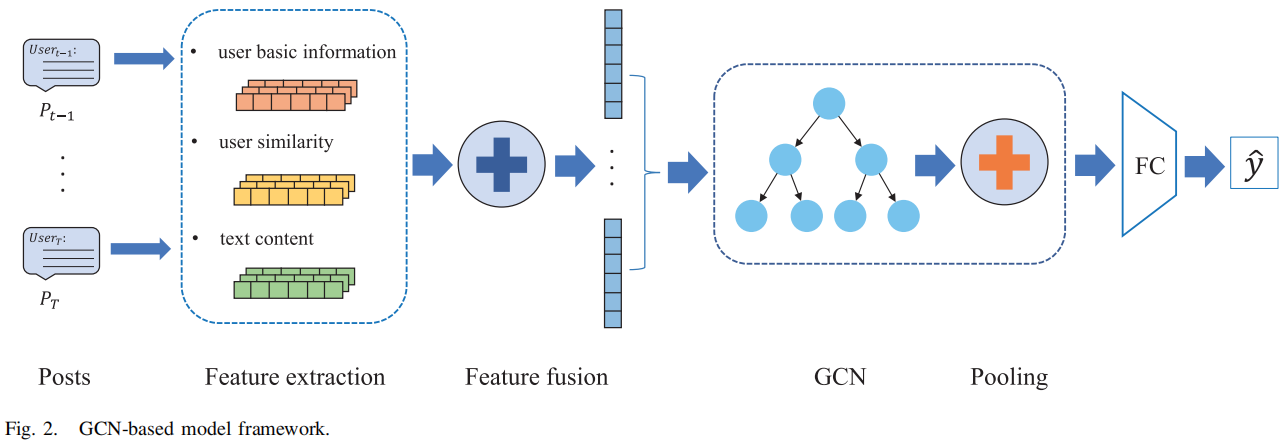
主要包括如下四个模块:
- the feature extraction module
- the feature fusion module
- the graph convolution module
- the pooling module
2.1.1 Features of User Basic Information
常见的 User basic information:
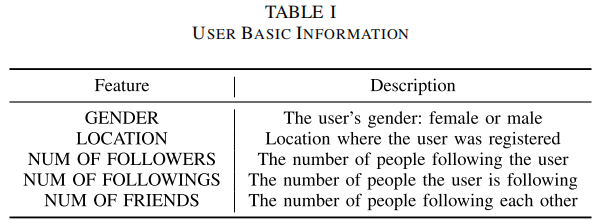
加入这些特征的原因:如 gender 为 女的情况下,是谣言的概率更高。
特征预处理:
对于 gender 采用 One-hot 向量;
对于追随者特征,采用的是 Min-Max normalization ,但是这对于普通用户(如拥有 follower 小的用户)用以造成大部分的数值为 $0$,所以本文采用 $\text{log}$ 处理,如下:
$x^{*}=\left\{\begin{array}{ll}\frac{\log x-\log x_{\min }}{\log x_{\max }-\log x_{\min }} & x>0 \\0 & x=0\end{array}\right\} \quad\quad\quad(2)$
其中,$x$ 代表归一化前的追随者数量,$x^{*} $ 表示标准化值,$x_{\min }$ 和 $x_{\max }$ 表示中的最小和最大追随者数量。
2.1.2 User Similarity Feature
考虑用户相似性,首先构造一个 user-event matrix $M$,其中 User 有 $N_{1}$ 个,event 有 $N_{2}$ 个,所以 $M \in N_{1} \times N_{2}$ 。可以预见的是 $M$ 是一个稀疏矩阵,所以本文采用 SVD 分解:
$A=U \Sigma V^{T}\quad\quad\quad(3)$
其中 $A$ 为需要分解的矩阵,$U$ 为左奇异值矩阵,$\Sigma$ 为对角矩阵,对角元素为奇异值,$V$ 为右奇异值矩阵。根据奇异值分解在推荐系统中的应用思想,我们可以取前 $N$ 个奇异值,计算 $\Sigma$ 与 $U$ 之间的点积,得到用户的向量表示,从而实现降维的目的。最后,每个用户都将有一个 $N$ 维的向量表示。两个用户向量之间的距离越近,它们共同参与的事件的数量就越多。基于同样的思想,还可以构建 users-users 之间的矩阵,矩阵元素表示两个用户都参与的事件的数量。然后使用相同的方法为用户生成另一组向量特征,并将基于用户-事件矩阵分解为用户相似性特征的向量相结合。
2.1.3 Representation of Text Content
使用 $BERT_{base}$ Chinese model 提取文本表示。
2.1.4 Feature Fusion Module
$\begin{array}{l}\mu \leftarrow \frac{1}{m} \sum\limits_{i=0}^{m} h_{i} \\\sigma^{2} \leftarrow \frac{1}{m} \sum\limits_{i=0}^{m}\left(h_{i}-\mu\right)^{2} \\\hat{h}_{l} \leftarrow \frac{h_{i}-\mu}{\sqrt{\sigma^{2}+\varepsilon}} \\w_{i} \leftarrow \gamma \hat{h}_{i}+\beta\end{array}$
其中,$\gamma$ 和 $\beta$ 是可学习参数。
最后再执行 concat 。
2.1.5 Graph Convolution Module
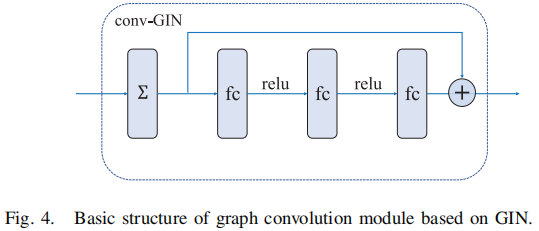
GCN 可以编码局部图的结构和节点特征。其正向传播公式如下:
$H^{(l+1)}=\sigma\left(\tilde{D}^{-\frac{1}{2}} \tilde{A} \tilde{D}^{-\frac{1}{2}} H^{(l)} W^{(l)}\right) \quad\quad\quad(8)$
$w_{v}^{k}=N N^{k}\left(\left(1+\varepsilon^{k}\right) \cdot w_{v}^{k-1}+\sum\limits _{u \in N(v)} w_{u}^{k-1}\right)$
2.1.6 Pooling Module
常见的池化操作包括 average pooling 和 maximum pooling,分别如 $\text{Eq.11}$ $\text{Eq.12}$ 所示:
$\begin{array}{l}h_{G}=\frac{1}{m} \sum\limits _{i=0}^{m} \widetilde{w_{i}} \\h_{G}=\max \left(\widetilde{w_{0}}, \widetilde{w_{1}}, \ldots, \widetilde{w_{m}}\right)\end{array}$
平均池化是为了获得图中所有节点的平均向量作为图向量,最大池化是选择此维度中所有节点的最大值作为每个维度的输出。
Note:一种新的池化方案,先将节点的表示向量按值降序排列后,选择顶部的 $k$ 个节点,拼接 $k$ 节点向量后,采用一维卷积法进行特征压缩,压缩后的向量为最终的图表示。
本文采取的池化过程:将GIN 每层的输入进行concat ,然后使用 Note 中的池化策略。
$h_{G}=\operatorname{Pooling}\left(\text { Concat }\left(\left\{\widetilde{w_{v}^{k}} \mid k=0,1, \ldots, K\right\}\right) \mid v \in V\right)$
3 Experiment
Dataset
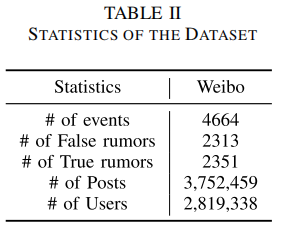
Results
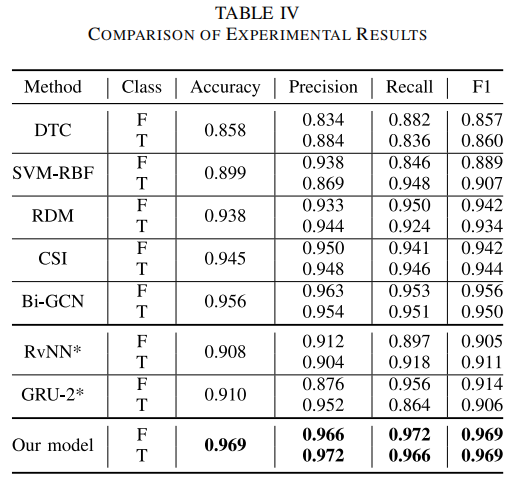
谣言检测()《Data Fusion Oriented Graph Convolution Network Model for Rumor Detection》的更多相关文章
- 谣言检测——《MFAN: Multi-modal Feature-enhanced Attention Networks for Rumor Detection》
论文信息 论文标题:MFAN: Multi-modal Feature-enhanced Attention Networks for Rumor Detection论文作者:Jiaqi Zheng, ...
- 论文解读(FedGAT)《Federated Graph Attention Network for Rumor Detection》
论文信息 论文标题:Federated Graph Attention Network for Rumor Detection论文作者:Huidong Wang, Chuanzheng Bai, Ji ...
- 谣言检测(ClaHi-GAT)《Rumor Detection on Twitter with Claim-Guided Hierarchical Graph Attention Networks》
论文信息 论文标题:Rumor Detection on Twitter with Claim-Guided Hierarchical Graph Attention Networks论文作者:Erx ...
- 谣言检测(PSIN)——《Divide-and-Conquer: Post-User Interaction Network for Fake News Detection on Social Media》
论文信息 论文标题:Divide-and-Conquer: Post-User Interaction Network for Fake News Detection on Social Media论 ...
- 谣言检测()——《Debunking Rumors on Twitter with Tree Transformer》
论文信息 论文标题:Debunking Rumors on Twitter with Tree Transformer论文作者:Jing Ma.Wei Gao论文来源:2020,COLING论文地址: ...
- 谣言检测(PLAN)——《Interpretable Rumor Detection in Microblogs by Attending to User Interactions》
论文信息 论文标题:Interpretable Rumor Detection in Microblogs by Attending to User Interactions论文作者:Ling Min ...
- 谣言检测(RDEA)《Rumor Detection on Social Media with Event Augmentations》
论文信息 论文标题:Rumor Detection on Social Media with Event Augmentations论文作者:Zhenyu He, Ce Li, Fan Zhou, Y ...
- 谣言检测()《Rumor Detection with Self-supervised Learning on Texts and Social Graph》
论文信息 论文标题:Rumor Detection with Self-supervised Learning on Texts and Social Graph论文作者:Yuan Gao, Xian ...
- 目标检测系列 --- RCNN: Rich feature hierarchies for accurate object detection and semantic segmentation Tech report
目标检测系列 --- RCNN: Rich feature hierarchies for accurate object detection and semantic segmentation Te ...
- 谣言检测——(PSA)《Probing Spurious Correlations in Popular Event-Based Rumor Detection Benchmarks》
论文信息 论文标题:Probing Spurious Correlations in Popular Event-Based Rumor Detection Benchmarks论文作者:Jiayin ...
随机推荐
- Python logging日志管理
import logging logger = logging.getLogger("simple_example") logger.setLevel(logging.DEBUG) ...
- cache2go-源码阅读
简介 cache2go 是非常简短的 go 开源项目了,很适合作为第一个读源码项目. 如果你有一定的 go 开发经验,读起来会感觉到比较容易. 如果你刚刚接触 go 语音,基础知识还不完全了解,希望阅 ...
- PhpStorm 中文设置教程
本文仅供学习交流使用,如侵立删!demo下载见文末 Pycharm中文设置教程 1.首先打开PhpStorm ,点击file-settings.找到plugins,搜索Marketplace,然后搜索 ...
- MySQL之COUNT(*)性能到底如何?
GreatSQL社区原创内容未经授权不得随意使用,转载请联系小编并注明来源. GreatSQL是MySQL的国产分支版本,使用上与MySQL一致. 前言 在实际开发过程中,统计一个表的数据量是经常遇到 ...
- 6. MGR状态监控 | 深入浅出MGR
GreatSQL社区原创内容未经授权不得随意使用,转载请联系小编并注明来源. 目录 1. 节点状态监控 2. MGR事务状态监控 3. 其他监控 4. 小结 参考资料.文档 免责声明 文章推荐: 关于 ...
- SQL Server查询优化
从上至下优化 看过一篇文章,印象深刻,里面将数据库查询优化分为四个大的方向 使用钞能力--给DB服务器加物理配置,内存啊,CPU啊,硬盘啊,全上顶配 替换存储系统--根据实际的业务情况选择不同的存储数 ...
- Taurus.MVC WebAPI 入门开发教程5:控制器安全校验属性【HttpGet、HttpPost】【Ack】【Token】【MicroService】。
系列目录 1.Taurus.MVC WebAPI 入门开发教程1:框架下载环境配置与运行. 2.Taurus.MVC WebAPI 入门开发教程2:添加控制器输出Hello World. 3.Tau ...
- Spring源码 07 IOC refresh方法2
参考源 https://www.bilibili.com/video/BV1tR4y1F75R?spm_id_from=333.337.search-card.all.click https://ww ...
- SpringBoot 注解简介(持续更新)
虽然工作中交替会使用spring mvc 和spring boot 框架,但实际对spring中的很多注解并不是很了解,本篇将持续更新学习到的spring 注解. Spring 主入口类上的注解 Sp ...
- 【java】学习路径23-拆箱与装箱
拿Integer类型和int类型来举例子. 装箱,基本给引用.下面的代码相当于Integer i_test = Integer.valueOf("100"); 注意!过程是自动的. ...
